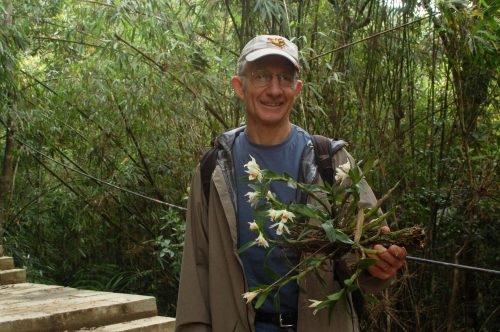
I am a Distinguished Professor in the Florida Museum of Natural History and Department of Biology at the University of Florida. My research interests in plant biology are diverse—we study plant evolution using modern DNA approaches including next generation sequencing methods and the use of “big data” sets that require challenging computational analyses; specific interests include plant phylogeny, genome doubling (polyploidy), floral evolution, angiosperm diversification, and phylogeography. Several of these areas are discussed below.
Working with others, we have reconstructed relationships among major lineages of flowering plants helping to build the tree of life for this large group. He continues research in this area building large data sets of plastid and nuclear gene sequences as part of the 1KP project (One thousand plant transcriptomes). Soltis and others are sequencing and analyzing 1,000 green plant transcriptomes and using those data to clarify unresolved areas of the green plant (and angiosperm) tree, and to pinpoint where ancient polyploidy events occurred throughout evolution. He is also working with Chinese collaborators to build a tree of life for the plants of China (~30,000 species) and with colleagues at the University of Florida is completing a phylogeny of most of the vascular plant species of Florida. This tree will be used to ecological and evolutionary questions in Florida (e.g., response to climate change and insights into invasive species).
Using the phylogenetic trees we have constructed for angiosperms (see above) and collaborating with others we have proposed a new classification for angiosperms and developed a fundamentally new form of classification (Angiosperm Phylogeny Group). These new classifications represent the most dramatic changes in angiosperm relationships in over 100 years. This phylogenetic framework formed the basis for the Floral Genome Project and the Ancestral Angiosperm Genome Project, both of which used genomic tools to address a fundamental problem: the origin of the flower.
At a larger phylogenetic scale, I am part of a recently funded effort to build a first-draft tree of life for all of the 1.8 million species on Earth. The first draft of this tree, the first ever comprehensive tree of life for all named species on earth, will be available in the fall of 2014.
Our phylogenetic work also revealed that Amborella is basal (or sister) to all other living angiosperms. Amborella is therefore to flowering plants what the platypus is to mammals. This prompted the Amborella Genome Sequencing Initiative. Soltis and collaborators recentlt released the first draft assembled genome of Amborella, which will serve as an evolutionary reference for all other flowering plants.
We are also using genomic approaches (e.g., microarrays and transcriptomes) to investigate the earliest living lineages of flowering plants to provide novel insights into the first flowers. We have discovered that floral organs (e.g. sepals, petals, stamens, carpels) of early angiosperms have broadly overlapping patterns of gene expression and not the highly distinctive, organ-specific patterns found in most flowers. This work showed that the classical ABC model (Arabidopsis) does not completely hold for basal angiosperms but is derived; this prompted our lab to propose the “fading borders” model for floral organ identity in basal angiosperms.
The Soltis lab is also at the forefront of detailed analysis of polyploidy. Over the past 25 years our work has helped replace the traditional paradigm of polyploidy evolution with a modern “revised synthesis” showing that autopolyploids are prevalent, not rare, that polyploids have increased genetic versatility, undergo rapid genomic change, and may form repeatedly. We have also shown that autopolyploidy is much more prevalent than historically maintained. We have developed two recently formed polyploids in Tragopogon (sunflower family) as “evolutionary models” for the study of recent and repeated natural polyploidization. Our work has provided new insights into the genetic and genomic changes that accompany polyploidy. Tragopogon has now become a text book example of allopolyploidy.
We have also investigated polyploidy at very deep levels. Using genomic approaches we found that the common ancestor of all angiosperms experienced a whole-genome duplication event. We have also shown that numerous ancient polyploidy events have occurred throughout angiosperm history; these are probably responsible not only for the success of flowering plants, but also for several key major diversification events in angiosperm history.
We are also interested in phylogeography. Our lab pioneered the study of phylogeography in plants with very early DNA studies focused on plants in the Pacific Northwest. These studies revealed a consistent genetic break between plants (later found in animals) to the north and south of a line in central Oregon—this genetic discontinuity (attributed to isolation during the Pleistocene). The Soltis lab now investigates plant phylogeography in the southeastern U.S.